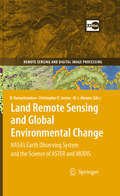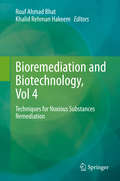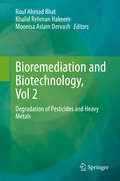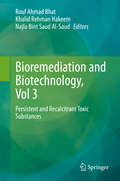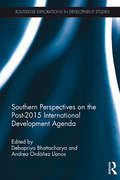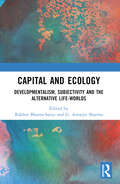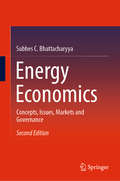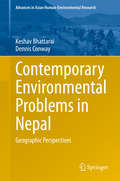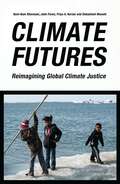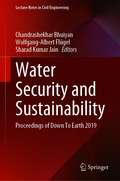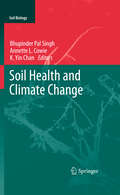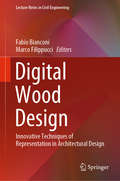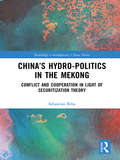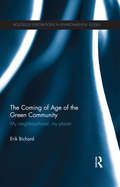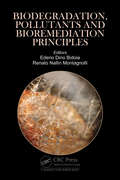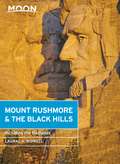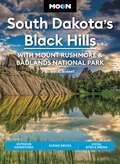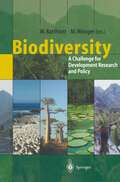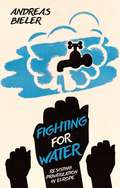- Table View
- List View
Land Remote Sensing and Global Environmental Change: NASA's Earth Observing System and the Science of ASTER and MODIS (Remote Sensing and Digital Image Processing #11)
by Bhaskar Ramachandran, Christopher O. Justice and Michael J. AbramsLand Remote Sensing and Global Environmental Change: The Science of ASTER and MODIS is an edited compendium of contributions dealing with ASTER and MODIS satellite sensors aboard NASA's Terra and Aqua platforms launched as part of the Earth Observing System fleet in 1999 and 2002 respectively. This volume is divided into six sections. The first three sections provide insights into the history, philosophy, and evolution of the EOS, ASTER and MODIS instrument designs and calibration mechanisms, and the data systems components used to manage and provide the science data and derived products. The latter three sections exclusively deal with ASTER and MODIS data products and their applications, and the future of these two classes of remotely sensed observations.
Bioremediation and Biotechnology, Vol 4: Techniques for Noxious Substances Remediation
by Rouf Ahmad Bhat Khalid Rehman HakeemThe rapid thriving of industries, conversion of agricultural land to residential areas, habitat destruction, deforestation and use of recalcitrant synthetic substances enhanced the rate of degradation of the environment. Although there are various conventional techniques for degradation and cleaning of noxious pollutants from disturbed environs, they are energy inefficient and costly to install. Bioremediation has emerged recently as an alternative and novel approach to manage and control environmental pollutants. This volume focuses explicitly on the remediation of noxious substances in stressed environs. It includes expert-contributed chapters on bio-monitoring by way of evaluating the relationship of biota with the polluted/stressed environs, sustainable plant-based degradation of noxious pollutants, and the application of biotechnologies to achieve tailored responses.Academicians, researchers, scientists and students will find this work essential for sustainable treatment of noxious pollutants. This book also serves as a core guide for training, teaching and research in conservation biology and environmental rehabilitation.
Bioremediation and Biotechnology, Vol 2: Degradation of Pesticides and Heavy Metals
by Rouf Ahmad Bhat Khalid Rehman Hakeem Moonisa Aslam DervashThis book addresses the grave concerns stemming out due to conventional treatment techniques. The main focus of this book revolves round the central kernel of novel technology (bioremediation and biotechnology) which has emerged as an independent warrior to clean up and restore the disturbed environs. Furthermore, this book is a coherent assortment of diverse chapters relevant to the role of biotechnology and bioremediation for restoration of the ecosystems degraded by pesticide and heavy metal pollution. The inaugural chapters deal with the quantification of problem and its magnitude due to pesticides and heavy metals, followed by innovative modern biotechnological and bioremediation treatment technologies and sustainable techniques to remediate the persistent pollutants. It is a detailed comprehensive account for the treatment technologies from unsustainable to sustainable. Academicians, researchers and students shall find it as a complete wrap up regarding biotechnological intervention for sustainable treatment of pollution and shall suffice for the diverse needs of teaching and research.
Bioremediation and Biotechnology, Vol 3: Persistent and Recalcitrant Toxic Substances
by Rouf Ahmad Bhat Khalid Rehman Hakeem Najla Bint Saud Al-SaudHealthy environment is important for any kind of biota on earth. It provides the basic elements of life such as clean water, fresh air, fertile soil and supports ecosystem of the food chain. Pollution drastically alters quality of the environment by changing the physico-chemical and biological aspects of these components. Accordingly, toxic metals, combustible and putrescible substances, hazardous wastes, explosives and petroleum products are all examples of inorganic and organic compounds that cause contaminations. Specifically, pollution of toxic and heavy metal in the environment is a growing problem worldwide, currently at an alarming rate. Toxic metals threaten the aquatic ecosystems, agriculture and ultimately human health. Traditional treatment techniques offer certain advantages such as rapid processing, ease of operation and control and flexibility. But, they could not maintain the quality of the environment due to the high operational costs of chemicals used, high energy consumption and handling costs for sludge disposal and overburden of chemical substances which irreversibly affect and destroy biodiversity, which ultimately render the soil useless as a medium for plant growth. Therefore, bioremediation and biotechnology, carried out by living assets to clean up, stabilize and restore contaminated ecosystems, have emerged as promising, environmental friendly and affordable approaches. Furthermore, the use of microbes, algae, transgenic plants and weeds adapted to stressful environments could be employed to enhance accumulation efficiency. Hence, sustainable and inexpensive processes are fast emerging as a viable alternative to conventional remediation methods, and will be most suitable for developing countries.In the current volume, we discuss pollution remediation challenges and how living organisms and the latest biotechnological techniques could be helpful in remediating the pollution in ecofriendly and sustainable ways.
Southern Perspectives on the Post-2015 International Development Agenda (Routledge Explorations in Development Studies)
by Debapriya Bhattacharya Andrea Ordóñez LlanosAt the turn of the millennium, the unanimous adoption of the Millennium Development Goals (MDGs) by the United Nations General Assembly marked a new chapter in international development. However, voices from the Global South were noticeably absent in shaping the agenda. Fifteen years later, the global context has changed so much that it would have been inconceivable not to have taken voices from the South into account when planning the new Sustainable Development Goals (SDGs). Since its inception in 2012, the Southern Voice on Post-MDG International Development Goals (Southern Voice), a network of 48 think tanks from Africa, Asia and Latin America, has generated a substantial body of original research to feed into various aspects of the post-2015 development agenda, such as the missing dimensions of the MDGs, ways to mitigate existing challenges in delivering on aspired outcomes, and new issues, goals, targets and indicators that are crucial for the next global development framework. Southern Perspectives on the Post-2015 International Development Agenda consolidates this research and stitches together development realities and policy experiences from the Global South, infusing unique local perspectives to the global debate on the post-2015 agenda. The compendium addresses the overarching themes underpinning the new international development framework by focusing on issues such as sustainability and growth, inclusion and social policies, governance and capacities, and financing of the new agenda. Southern Voice seeks to challenge the "knowledge asymmetry" afflicting the global knowledge system by channelling evidence-based policy analyses produced by centres of excellence, located in the Global South. This is a valuable resource for academics and researchers, policymakers and practitioners, and concerned students in search of alternative views on sustainable development.
Southern Perspectives on the Post-2015 International Development Agenda (Routledge Explorations in Development Studies)
by Debapriya Bhattacharya Andrea Ordóñez LlanosAt the turn of the millennium, the unanimous adoption of the Millennium Development Goals (MDGs) by the United Nations General Assembly marked a new chapter in international development. However, voices from the Global South were noticeably absent in shaping the agenda. Fifteen years later, the global context has changed so much that it would have been inconceivable not to have taken voices from the South into account when planning the new Sustainable Development Goals (SDGs). Since its inception in 2012, the Southern Voice on Post-MDG International Development Goals (Southern Voice), a network of 48 think tanks from Africa, Asia and Latin America, has generated a substantial body of original research to feed into various aspects of the post-2015 development agenda, such as the missing dimensions of the MDGs, ways to mitigate existing challenges in delivering on aspired outcomes, and new issues, goals, targets and indicators that are crucial for the next global development framework. Southern Perspectives on the Post-2015 International Development Agenda consolidates this research and stitches together development realities and policy experiences from the Global South, infusing unique local perspectives to the global debate on the post-2015 agenda. The compendium addresses the overarching themes underpinning the new international development framework by focusing on issues such as sustainability and growth, inclusion and social policies, governance and capacities, and financing of the new agenda. Southern Voice seeks to challenge the "knowledge asymmetry" afflicting the global knowledge system by channelling evidence-based policy analyses produced by centres of excellence, located in the Global South. This is a valuable resource for academics and researchers, policymakers and practitioners, and concerned students in search of alternative views on sustainable development.
Capital and Ecology: Developmentalism, Subjectivity and the Alternative Life-Worlds
by Rakhee Bhattacharya G. Amarjit SharmaThis volume studies the intersection of capital and ecology primarily in one of the most sensitive geographies of the world, the Eastern Himalayan region. It looks at how the region has become a melting ground of neoliberal developmentalism and ecological subjectivities with the penetrating forces of global and state capitalism, economic projects, and complex power relations. The essays in the volume argue that specific focus on energy infrastructure and energy production has pushed technology and capital towards asset building which has had an adverse effect on the environment, labour relations, indigenous knowledge systems, and traditional livelihood practices in the area. They look at assets like mega dams, electricity transmission networks, natural gas grids, infrastructural and developmental projects, and other alternative ventures which require interventions in the natural world and its resource deposits. Interdisciplinary in approach, the volume adopts a variety of lenses — developmentalism, state strategy, indigenous voices, geopolitics, and environmentalism — to provide a unique and alternative narrative on the various dimensions of the ecological risks and livelihood threats. It will be of great interest to scholars and researchers of politics, development studies, indigenous studies, and Asian studies.
Energy Economics: Concepts, Issues, Markets and Governance
by Subhes C. BhattacharyyaThis book provides an updated and expanded overview of basic concepts of energy economics and explains how simple economic tools can be used to analyse contemporary energy issues in the light of recent developments, such as the Paris Agreement, the UN Sustainable Development Goals and new technological developments in the production and use of energy. The new edition is divided into four parts covering concepts, issues, markets, and governance. Although the content has been thoroughly revised and rationalised to reflect the current state of knowledge, it retains the main features of the first edition, namely accessibility, research-informed presentation, and extensive use of charts, tables and worked examples.This easily accessible reference book allows readers to gain the skills required to understand and analyse complex energy issues from an economic perspective. It is a valuable resource for students and researchers in the field of energy economics, as well as interested readers with an interdisciplinary background.
Contemporary Environmental Problems in Nepal: Geographic Perspectives (Advances in Asian Human-Environmental Research)
by Keshav Bhattarai Dennis ConwayThis monograph examines contemporary environmental challenges facing Nepal, this landlocked country’s representativeness in the wider South Asian context is both distinct and generalizable. In large part, this is because of its extremes of physiographical structure- plains, hill ranges, mountainous massifs - and wide range of altitudinal terrains, which represent and replicate South Asian and East Asian continental conditions differing as markedly as humid tropical lowlands, sub-tropical hill ranges and temperate to sub-arctic mountainous environments. Associated forest regimes, in which deforestation and reforestation patterns have evolved in recent times, and differing densities of settlement and cleared agricultural landscapes in each of these altitudinal zones, add to the environmental diversity of Nepal. Associated fauna and exotic species are in various states of endangerment especially Bengal tigers, one horned rhinos, wild elephants, crocodile, musk deer, and peasants, to name a few- so that their forested and mountainous habitats as ‘Wild Life Reserves’ also deserve our attention, and are featured in this monograph’s remit.
Climate Futures: Re-imagining Global Climate Justice
by Kum-Kum Bhavnani John Foran Priya A. Kurian Debashish MunshiApproaching the issues of climate change and climate justice from a range of diverse perspectives including those of culture, gender, indigeneity, race, and sexuality, as well as challenging colonial histories and capitalist presents, Climate Futures boldly addresses the apparent inevitability of climate chaos.Seeking better explanations of the underlying causes and consequences of climate change, and mapping strategies toward a better future, or at a minimum, the most likely best-case world that we can get to, this book envisions planetary social movements robust enough to spark the necessary changes needed to achieve deeply sustainable and just economic, social, and political policies and practices.Bringing together insights from interdisciplinary scholars, policymakers, creatives and activists, Climate Futures argues for the need to get past us-and-them divides and acknowledge how lives of creatures far and near, human and non-human, are interconnected.
Water Security and Sustainability: Proceedings of Down To Earth 2019 (Lecture Notes in Civil Engineering #115)
by Chandrashekhar Bhuiyan Wolfgang-Albert Flügel Sharad Kumar JainThis book contains selected peer-reviewed papers presented in the International Conference Down To Earth 2019, and is focused on Water Security and Sustainability. The topics covered in this book include sustainability of water resources, geospatial modelling and hydro-informatics, extreme hydrology (drought and flood), adaptation to climate-change impacts, vulnerability-risk-reliability-resilience, and hydrological risks in north-east India. The book also discusses innovative techniques and technologies for water resources assessment and management. Enriched with numerous case studies covering diverse topics, the book can be valuable for students, researchers, as well as industry professionals interested in water resources assessment, management and sustainable development.
Soil Health and Climate Change (Soil Biology #29)
by Bhupinder Pal Singh, Annette L. Cowie and K. Yin Chan“Soil Health and Climate Change” presents a comprehensive overview of the concept of soil health, including the significance of key soil attributes and management of soil health in conventional and emerging land use systems in the context of climate change.Starting with a review of the physical, chemical and biological indicators of soil health and their significance for monitoring the impacts of climate change, this book then focuses on describing the role of soil structure, pH, organic matter, nitrogen, respiration and biota in sustaining the basic functions of soil ecosystems, and their anticipated responses to climate change. Further topics include the management of cropping, pastoral, and forestry systems, and rehabilitated mine sites, with a focus on mitigation of and adaptation to climate change impacts. Finally, the opportunities and potential risks of organic farming, biochar and bioenergy systems, and their ability to sustain and even enhance soil health, are discussed.
Digital Wood Design: Innovative Techniques of Representation in Architectural Design (Lecture Notes in Civil Engineering #24)
by Fabio Bianconi Marco FilippucciThis book explores various digital representation strategies that could change the future of wooden architectures by blending tradition and innovation. Composed of 61 chapters, written by 153 authors hailing from 5 continents, 24 countries and 69 research centers, it addresses advanced digital modeling, with a particular focus on solutions involving generative models and dynamic value, inherent to the relation between knowing how to draw and how to build. Thanks to the potential of computing, areas like parametric design and digital manufacturing are opening exciting new avenues for the future of construction. The book’s chapters are divided into five sections that connect digital wood design to integrated approaches and generative design; to model synthesis and morphological comprehension; to lessons learned from nature and material explorations; to constructive wisdom and implementation-related challenges; and to parametric transfigurations and morphological optimizations.
China’s Hydro-politics in the Mekong: Conflict and Cooperation in Light of Securitization Theory (Routledge Contemporary China Series)
by Sebastian BibaChina’s Hydro-politics in the Mekong explores the intricate processes of conflict and cooperation over the use of water resources in the Mekong river basin between upstream China and the downstream countries of Laos, Thailand, Cambodia, and Vietnam. The book tackles two gaps in the empirical literature: first, the neglect of international hydro-politics as one specific and increasingly important issue area of China’s foreign policy behavior, especially its neighborhood diplomacy; and second, the disregard of China’s role in Mekong River politics. In particular, this book scrutinizes the ‘spring 2010 Mekong crisis’ and the events surrounding it which led to a series of complex multi-level, security-related interactions among various state and non-state actors in the region, with China at the center. Analyzing this crisis, the book not only employs securitization theory as its theoretical framework and adds a couple of innovations to this theory, but also gives a detailed account of China’s hydro-political behavior in one specific and particularly revealing case study. Moreover, the book embeds China’s Mekong hydro-politics in the bigger picture of its (sub-)regional international affairs, as the former does not take place in a vacuum, but rather is a part of China’s overall foreign relations with its neighbors. The book acknowledges this link and provides new insights into the role of hydro-politics and its relationship vis-à-vis other issue areas of China’s foreign policy.
China’s Hydro-politics in the Mekong: Conflict and Cooperation in Light of Securitization Theory (Routledge Contemporary China Series)
by Sebastian BibaChina’s Hydro-politics in the Mekong explores the intricate processes of conflict and cooperation over the use of water resources in the Mekong river basin between upstream China and the downstream countries of Laos, Thailand, Cambodia, and Vietnam. The book tackles two gaps in the empirical literature: first, the neglect of international hydro-politics as one specific and increasingly important issue area of China’s foreign policy behavior, especially its neighborhood diplomacy; and second, the disregard of China’s role in Mekong River politics. In particular, this book scrutinizes the ‘spring 2010 Mekong crisis’ and the events surrounding it which led to a series of complex multi-level, security-related interactions among various state and non-state actors in the region, with China at the center. Analyzing this crisis, the book not only employs securitization theory as its theoretical framework and adds a couple of innovations to this theory, but also gives a detailed account of China’s hydro-political behavior in one specific and particularly revealing case study. Moreover, the book embeds China’s Mekong hydro-politics in the bigger picture of its (sub-)regional international affairs, as the former does not take place in a vacuum, but rather is a part of China’s overall foreign relations with its neighbors. The book acknowledges this link and provides new insights into the role of hydro-politics and its relationship vis-à-vis other issue areas of China’s foreign policy.
The Coming of Age of the Green Community: My neighbourhood, my planet (Routledge Explorations in Environmental Studies)
by Erik BichardPeople organising to protect their environment is not a new phenomenon, but the groups that have been pushing for environmental change since the 1970s have not convinced sufficient numbers make sustainable decisions or to lead sustainable lives. Governments have serially failed to do the job at the international level. Now, climate change, resource depletion and widening social aspirations threaten to destabilise human society unless sustainable change can be influenced from another direction. The Coming of Age of the Green Community explores the activities of a new generation of community-led initiatives that may herald the beginnings of the next wave of activism. Erik Bichard combines the testimonies of dozens of group activists with historic evidence and the views of a range of commentators from a variety of disciplines to put forward reasons why some green community groups succeed while others fail. He concludes with a valuable prescription for both existing and emerging groups on how to be sustainable, both over time and in their actions. This book address one of the key questions of the twenty-first century: has the local perspective on this universal concern finally come of age?
The Coming of Age of the Green Community: My neighbourhood, my planet (Routledge Explorations in Environmental Studies)
by Erik BichardPeople organising to protect their environment is not a new phenomenon, but the groups that have been pushing for environmental change since the 1970s have not convinced sufficient numbers make sustainable decisions or to lead sustainable lives. Governments have serially failed to do the job at the international level. Now, climate change, resource depletion and widening social aspirations threaten to destabilise human society unless sustainable change can be influenced from another direction. The Coming of Age of the Green Community explores the activities of a new generation of community-led initiatives that may herald the beginnings of the next wave of activism. Erik Bichard combines the testimonies of dozens of group activists with historic evidence and the views of a range of commentators from a variety of disciplines to put forward reasons why some green community groups succeed while others fail. He concludes with a valuable prescription for both existing and emerging groups on how to be sustainable, both over time and in their actions. This book address one of the key questions of the twenty-first century: has the local perspective on this universal concern finally come of age?
Trophy Hunting
by Nikolaj Bichel Adam HartThis book gets to the heart of trophy hunting, unpacking and explaining its multiple facets and controversies, and exploring why it divides environmentalists, the hunting community, and the public. Bichel and Hart provide the first interdisciplinary and comprehensive approach to the study of trophy hunting, investigating the history of trophy hunting, and delving into the background, identity and motivation of trophy hunters. They also explore the role of social media and anthropomorphism in shaping trophy hunting discourse, as well as the viability of trophy hunting as a wildlife management tool, the ideals of fair chase and sportsmanship, and what hunting trophies are, both literally and in terms of their symbolic value to hunters and non-hunters. The analyses and discussions are underpinned by a consideration of the complex moral and practical conflicts between animal rights and conservation paradigms. This book appeals to scholars in environmental philosophy, conservation and environmental studies, as well as hunters, hunting opponents, wildlife management practitioners, and policymakers, and anyone with a broad interest in human–wildlife relations.
Oxygen Transport to Tissue—IV (Advances in Experimental Medicine and Biology #159)
by Haim I. BicherThe International Society on OXygen Transport to Tissue (ISO'IT) has canpleted nine years as a society since its first fonnal meeting at Charleston-Clanson, South Carolina, United States of America in 1973. Prior to this time an active group of scientists and engineers rret in w::>rkshop environrrents, on a periodic basis, around the w::>rld. Meetings are ncM on an annual basis, alternating between Europe and the United States. The international gatherings include scientists and engineers in a variety of fields. ISOIT has produced a stable forum for the exchange of info:rmation on the rnicroenvirornnent of living cells, ranging fran the utilization of mathematics and engineering, through physiology and radiobiology, to clinical applications. The proceedings of these meetings have been codified into six books, four of them published by Plenum Press in its prestigious Advances in Experimental Medicine and Biology series. This volume, together with the next two volumes that will follCJV.l the meetings in Dortmund, Gennany in 1982 and in Ruston, Louisiana in 1983 will provide further chapters in the history of this fascinating field of knCJV.lledge. OUr thanks are given to all the participants and contributors to the Detroit meeting. We hope that the strength of the society will grow in caning years, and that our contribution will eventually be felt in :inproving the treatment of the sick, and in enhancing the thought processes of the intellectual.
Biodegradation, Pollutants and Bioremediation Principles
by Ederio Dino BidoiaThis book presents a broad compendium of biodegradation research and discussions on the most up-to-date bioremediation strategies. The most relevant microbiological, biochemical and genetic concepts are presented alongside the fundamentals of bioremediation. The topics include: a wide variety of contaminant impacts evaluation, key methodologies required to measure biodegradation and propose new bioremediation protocols, as well as the handling of microbial communities related to such processes. The selected collaborating authors are renowned for their microbiology expertise and will provide an in-depth reference for students and specialists. The contents provide a valuable source of information for researchers, professionals, and policy makers alike.
Biodegradation, Pollutants and Bioremediation Principles
by Ederio Dino Bidoia Renato Nallin MontagnolliThis book presents a broad compendium of biodegradation research and discussions on the most up-to-date bioremediation strategies. The most relevant microbiological, biochemical and genetic concepts are presented alongside the fundamentals of bioremediation. The topics include: a wide variety of contaminant impacts evaluation, key methodologies required to measure biodegradation and propose new bioremediation protocols, as well as the handling of microbial communities related to such processes. The selected collaborating authors are renowned for their microbiology expertise and will provide an in-depth reference for students and specialists. The contents provide a valuable source of information for researchers, professionals, and policy makers alike.
Moon Mount Rushmore & the Black Hills: With the Badlands (Travel Guide)
by Laural A. BidwellExperience the open skies of the Badlands, the rolling prairies of the West, and one of America's most famous monuments with Moon Mount Rushmore & The Black Hills. Inside you'll find:Flexible Itineraries: Unique and adventure-packed ideas for day trips, a week on the road, families with kids, wildlife enthusiasts, and moreThe Best Hikes Near Mount Rushmore: Individual trail maps, mileage and elevation gains, and trailheadsExperience the Outdoors: Find ideas for horseback riding, rock climbing, backpacking, kayaking, biking, and more. Say hello to the carved granite faces of the presidents and hike red rock canyons and hills covered in ponderosa pine. Spot bison, elk, and mountain goats and see wild horses roaming the grassy flatlands. Climb the tallest peak east of the Rockies or navigate the underground passages of Wind Cave National Park Respectfully connect with Native American culture: Visit historic sites, galleries, and museums to learn about Lakota history, see the Crazy Horse Memorial, or attend a powwow ceremony to watch traditional dances and sample authentic cuisineHow to Get There: Up-to-date information on gateway towns, park entrances, park fees, and toursWhere to Stay: Campgrounds, resorts, hotels, and morePlanning Tips: When to go, what to pack, safety information, and how to avoid the crowds, with full-color photos and detailed maps throughoutExpertise and Know-How: Experience the best of this stunning region with Laural A. Bidwell, a local of South Dakota's Black Hills Get to know Mount Rushmore and the Black Hills your way with Moon.Craving more of the great outdoors? Check out Moon USA National Parks, Moon Zion & Bryce, or Moon Yellowstone & Grand Teton.
Moon South Dakota's Black Hills: Outdoor Adventures, Scenic Drives, Local Bites & Brews (Travel Guide)
by Laural A. BidwellExperience the open skies of the Badlands, the rolling prairies of the West, and one of America's most famous monuments with Moon South Dakota's Black Hills. Inside you'll find:Flexible itineraries: Unique and adventure-packed ideas for day trips, a week on the road, families with kids, wildlife enthusiasts, and more The best hikes in the Black Hills and Badlands, with individual trail descriptions, elevation gains, and trailheads Experience the outdoors: Go horseback riding, rock climbing, backpacking, kayaking, biking, and more. Say hello to the carved granite faces of the presidents and hike red rock canyons and hills covered in ponderosa pine. Spot bison, elk, and mountain goats and see wild horses roaming the grassy flatlands. Climb the tallest peak east of the Rockies or navigate the underground passages of Wind Cave National Park Respectfully connect with Native American culture: Visit historic sites, galleries, and museums to learn about Lakota history, see the Crazy Horse Memorial, or attend a powwow ceremony to watch traditional dances and sample authentic cuisine How to get there: Up-to-date information on gateway towns, park entrances, park fees, and tours Where to stay: Campgrounds, resorts, hotels, and more Planning tips: When to go, what to pack, safety information, and how to avoid the crowds, with full-color photos and detailed maps throughout Expertise and know-how: Experience the best of this stunning region with Laural A. Bidwell, a local of South Dakota's Black Hills Get to know South Dakota your way with Moon. Craving more of the great outdoors? Check out Moon USA National Parks, Moon Zion & Bryce, or Moon Yellowstone & Grand Teton. About Moon Travel Guides: Moon was founded in 1973 to empower independent, active, and conscious travel. We prioritize local businesses, outdoor recreation, and traveling strategically and sustainably. Moon Travel Guides are written by local, expert authors with great stories to tell—and they can't wait to share their favorite places with you. For more inspiration, follow @moonguides on social media.
Biodiversity: A Challenge for Development Research and Policy
by N. BiedingerBiodiversity, sometimes simply understood as "diversity of species", is a specific quality of life on our planet, the dimensions and importance of which have just lately been fully realized. Today we know that "biological diversity is a global asset of incalculable value to present and future generations" (Kofi Annan). Biodiversity is spread unequally over the world: in fact, the main share of biological resources worldwide is harboured predominantly by the so-called developing countries in the tropics and sub tropics. Therefore, Biodiversity - A Challenge for Development Research and Policy was chosen as the title for an international conference which was held in Bonn in 1997 as one of the first major events organized by the then newly established North-South Centre for Development Research (ZEF) at Rheinische Friedrich-Wilhelms-Universitat Bonn (Germany). Since the ZEF, founded by the Senate of the University of Bonn in 1995, has played a central role in turning Bonn into a centre for international cooperation and North-South dialogue. The Centre is a product of the Bonn Berlin agreement of July 1994 which was adopted to offset the effects caused by the Parliament and much of the Government moving to Berlin. It fits in well with the double strategy to strengthen Bonn's position as an interna tional science arena and as an eminent place for development policy and the national and supranational agencies dealing with this issue.
Fighting for Water: Resisting Privatization in Europe
by Andreas BielerIn the wake of the global financial crisis, water services have come under renewed neoliberal assault across Europe. At the same time, the struggle against water privatization has continued to pick up pace; from the re-municipalization of water in Grenoble in 2000, to the United Nations declaration of water as a human right in 2010.In Fighting for Water, Andreas Bieler draws on years of extensive fieldwork to dissect the underlying dynamics of the struggle for public water in Europe. By analysing the successful referendum against water privatization in Italy, the European Citizens' Initiative on 'Water and Sanitation are a Human Right', the struggles against water privatization in Greece and water charges in Ireland, Bieler shows why water has been a fruitful arena for resistance against neoliberal restructuring.
